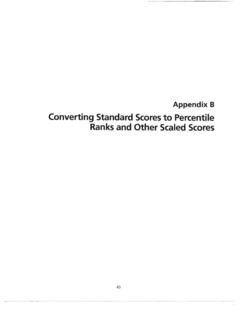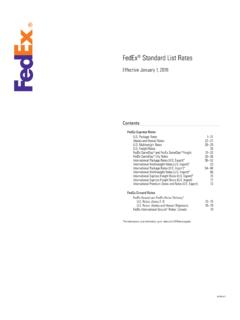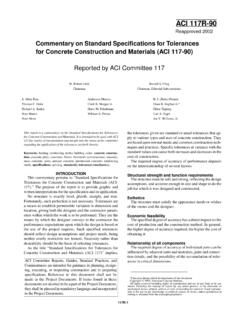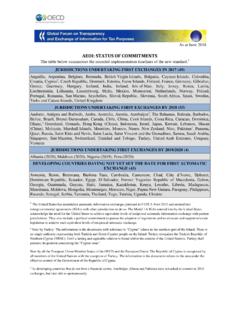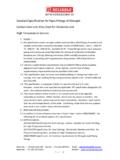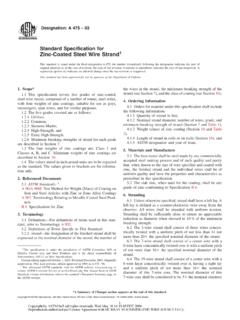Transcription of Pascal ISO 7185:1990
1 Pascal ISO 7185 :1990. This online copy of the unextended Pascal standard is provided only as an aid to standardization. In the case of differences between this online version and the printed version, the printed version takes precedence. Do not modify this document . Do not include this document in another software product . You may print this document for personal use only. Do not sell this document. Use this information only for good ; never for evil . Do not expose to fire . Do not operate heavy equipment after reading, may cause drowsiness . Do not read under the inuence of alcohol (although there have been several unconfirmed reports that alcohol actually improves the readability) . The standard is written in English . If you have trouble understanding a particular section, read it again and again and again .. Sit up straight . Eat your vegatables . Do not mumble. cISO/IEC 1991. ISO/IEC 7185 :1990(E). ii ISO/IEC 7185 :1990(E).
2 Acknowledgements The efforts are acknowledged of all those who contributed to the work of the BSI and ISO Pascal working groups, and in particular: Tony Addyman Harris Hall John Reagan Albrecht Biedl Carsten Hammer Mike Rees Bob Brewer Atholl Hay Arthur Sale Coen Bron Tony Hetherington Paula Schwartz David Burnett-Hall Steve Hobbs Barry Smith David Bustard Mel Jackson John Souter Barry Byrne Scott Jameson Manfred Stadel Klaus Daessler David Jones Bob Tennent Richard De Morgan David Joslin Tom Turba Norman Diamond Katsuhiko Kakehi Eiiti Wada Bob Dietrich Olivier Lecarme Willem Wakker Ken Edwards Jim Miner David Watt Jacques Farre Wes Munsil Jim Welsh Bill Findlay Bill Price Brian Wichmann The efforts are acknowledged of all those who contributed to the work of JPC, and in particular : Michael Alexander Steven Hobbs David L . Presberg Jeffrey Allen Albert A . Hoffman William C . Price Ed Barkmeyer Robert Hutchins Bruce Ravenal W.
3 Ashby Boaz Rosa C . Hwang David L . Reese Jack Boudreaux Scott Jameson David C . Robbins A . Winsor Brown David Jones Lynne Rosenthal Jerry R . Brookshire Steen Jurs Tom Rudkin Tomas M . Burger Mel Kanner Stephen C . Schwarm David S . Cargo John Kaufmann Rick Shaw Richard J . Cichelli Leslie Klein Carol Sledge Joe Cointment Bruce Knobe Barry Smith Roger Cox Dennis Kodimer Rudeen S . Smith Jean Danver Ronald E . Kole Bill Stackhouse Debra Deutsch Alan A . Kortesoja Marius Troost Bob Dietrich Edward Krall Thomas N . Turba Victor A . Folwarczny Robert Lange Prescott K . Turner G . G . Gustafson Rainer McCown Howard Turtle Thomas Giventer Jim Miner Robert Tuttle Hellmut Golde Eugene N . Miya Richard C . Vile, Jr David N . Gray Mark Molloy Larry B . Weber Paul Gregory William Neuhauser David Weil Michael Hagerty Dennis Nicholson Thomas R . Wilcox Charles E . Haynes Mark Overgaard Thomas Wolfe Christopher Henrich Ted C.
4 Park Harvey Wohlwend iii ISO/IEC 7185 :1990(E). Steven Hiebert Donald D . Peckham Kenneth M . Zemrowski Ruth Higgins David Peercy Charles Hill Robert C . B . Poon (The above list is of people acknowledged in ANSI/IEEE770X3 .97-1983 .). iv ISO/IEC 7185 :1990(E). Introduction This International Standard provides an unambiguous and machine independent de finition of the programming language Pascal . Its purpose is to facilitate portability of Pascal programs for use on a wide variety of data processing systems. Language history The computer programming language Pascal was designed by Professor Niklaus Wirth to satisfy two principal aims a) to make available a language suitable for teaching programming as a systematic discipline based on certain fundamental concepts clearly and naturally reected by the language;. b) to define a language whose implementations could be both reliable and e ffi cient on then- available computers.
5 However, it has become apparent that Pascal has attributes that go far beyond these original goals. It is now being increasingly used commercially in the writing of both system and application software. This International Standard is primarily a consequence of the growing commercial interest in Pascal and the need to promote the portability of Pascal programs between data processing systems. In drafting this International Standard the continued stability of Pascal has been a prime objective. However, apart from changes to clarify the speci fication, two major changes have been introduced. a) The syntax used to specify procedural and functional parameters has been changed to require the use of a procedure or function heading, as appropriate (see 6 .6 .3 .1) ; this change was introduced to overcome a language insecurity. b) A fifth kind of parameter, the conformant-array-parameter, has been introduced (see 6 .6 .3.
6 7). With this kind of parameter, the required bounds of the index-type of an actual-parameter are not fixed, but are restricted to a speci fied range of values. Project history In 1977, a working group was formed within the British standards Institution (BSI) to produce a standard for the programming language Pascal . This group produced several working drafts, the first draft for public comment being widely published early in 1979 . In 1978, BSI's proposal that Pascal be added to ISO's program of work was accepted, and the ISO Pascal Working Group (then designated ISO/TC97/SC5/WG4) was formed in 1979 . The Pascal standard was to be published by BSI on behalf of ISO, and this British Standard referenced by the International Standard. In the USA, in the fall of 1978, application was made to the IEEE standards Board by the IEEE. Computer Society to authorize project 770 ( Pascal ) . After approval, the fi rst meeting was held in January 1979.
7 In December of 1978, X3J9 convened as a result of a SPARC ( standards Planning and Requirements Committee) resolution to form a US TAG (Technical Advisory Group) for the ISO Pascal standardization effort initiated by the UK . These efforts were performed under X3 project 317 . v ISO/IEC 7185 :1990(E). In agreement with IEEE representatives, in February of 1979, an X3 resolution combined the X3J9. and P770 committees into a single committee called the Joint X3J9/IEEE-P770 Pascal standards Committee . (Throughout, the term JPC refers to this committee .) The first meeting as JPC was held in April 1979. The resolution to form JPC clarified the dual function of the single joint committee to produce a dpANS and a proposed IEEE Pascal standard, identical in content. ANSI/IEEE770X3 .97-1983, American National Standard Pascal Computer Programming Language, was approved by the IEEE standards Board on September 17, 1981, and by the American National standards Institute on December 16, 1982.
8 British Standard BS6192, Specification for Computer programming language Pascal , was published in 1982, and International Standard 7185. (incorporating BS6192 by reference) was approved by ISO on December 1, 1983 . Differences between the ANSI and ISO standards are detailed in the Foreword of ANSI/IEEE770X3 .97-1983. In 1985, the ISO Pascal Working Group (then designated ISO/TC97/SC22/WG2, now ISO/IEC. JTC1/SC22/WG2) was reconvened after a long break . An Interpretations Subgroup was formed, to interpret doubtful or ambiguous portions of the Pascal standards . As a result of the work of this subgroup, and also of the work on the Extended Pascal standard being produced by WG2 and JPC, BS6192/ISO7185 was revised and corrected during 1988/89 ; it is expected that ANSI/IEEE770X3 .97-1983 will be replaced by the revised ISO 7185. The major revisions to BS6192 :1982 to produce the new ISO 7185 are: a) resolution of the differences with ANSI/IEEE770X3.
9 97-1983;. b) relaxation of the syntax of real numbers, to allow \digit sequences" rather than \unsigned integers" for the various components;. c) in the handling of \end-of-line characters" in text files;. d) in the handling of run-time errors. vi INTERNATIONAL STANDARD ISO/IEC 7185 :1990(E). Information technology | Programming languages | Pascal 1 Scope 1 .1. This International Standard specifi es the semantics and syntax of the computer programming language Pascal by specifying requirements for a processor and for a conforming program . Two levels of compliance are de fined for both processors and programs. 1 .2. This International Standard does not specify a) the size or complexity of a program and its data that will exceed the capacity of any speci fic data processing system or the capacity of a particular processor, nor the actions to be taken when the corresponding limits are exceeded;. b) the minimal requirements of a data processing system that is capable of supporting an implementation of a processor for Pascal .
10 C) the method of activating the program-block or the set of commands used to control the environment in which a Pascal program is transformed and executed;. d) the mechanism by which programs written in Pascal are transformed for use by a data processing system;. e) the method for reporting errors or warnings;. f) the typographical representation of a program published for human reading. 2 Normative reference The following standard contains provisions which, through reference in this text, constitute provisions of this International Standard . At the time of publication, the edition indicated was valid . All standards are subject to revision, and parties to agreements based on this International Standard are encouraged to investigate the possibility of applying the most recent edition of the standard listed below . Members of IEC and ISO maintain registers of currently valid International standards . ISO 646 :1983, Information processing|ISO 7-bit coded character set for information interchange.
